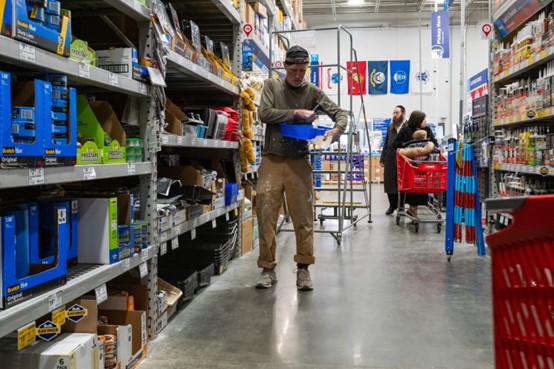
当抵押贷款利率如此之高以至于没有人能买房或进行抵押贷款再融资时,人们也会停止进行瓷砖填缝、粉刷和铺设瓷砖等工作——所有这些自己动手装修工作都是以供出售的必要项目。
这给零售商带来了巨大的痛苦。劳氏公司周三报告称,截至8月初的第二季度可比销售额下降了5.1%。该公司预计今年的零售业务销售额将下降3.5%至4%,而此前预计的降幅为2%至3%。劳氏公司自己动手业务的放缓与竞争对手家得宝(Home Depot)的情况如出一辙,后者在第二季度销售疲软后大幅下调了销售预期。家得宝目前预计,今年的可比销售额将下降3%至4%,这对于全球最大的家居装修和建筑用品零售公司来说是令人沮丧的前景,而该公司最初的预测是下降1%。
劳氏公司和家得宝在全美共有4000多家门店,它们承认正在等待时机,希望预期中的降息能让消费者再度热衷于戴上防护眼镜和手套重新装修台面。
劳氏公司首席执行官马文·埃里森(Marvin Ellison)表示:“我们都意识到,目前的环境利率升高、通货膨胀居高不下。正因为如此,自己动手客户只是在观望,等待某种形式的拐点出现。”
事实上,抵押贷款利率已降至一年来的最低点,但对家装门店来说,暂时的缓解不会很快到来。GlobalData零售业务常务董事尼尔·桑德斯(Neil Saunders)表示,自己动手相关消费通常会在施行新举措后6个月至1年达到峰值。因此,即使抵押贷款利率变得更有利,业余翻新项目也可能会搁置到2025年,哈佛大学(Harvard University)住房研究联合中心预测,明年住房维修支出将稳步增长。
因此,埃里森将销售下滑的主要原因归结于人们对厨房、浴室和地板等大额非必需品的购买兴趣减少——这是去年年底人们注意到的趋势的延续。他说,恶劣的天气也是原因之一,因为“在5月份的潮湿天气之后,全美大部分地区很快在6月和7月出现酷热天气”,扰乱了人们通常在春夏两季购买庭院家具和草坪护理用品的习惯。
埃里森在财报电话会议上表示:“我们仍有大约75%的自己动手业务。因此,这些大额非必需品类别的任何回落对我们的影响尤其严重。”
家得宝也采取了类似的做法。该公司董事长、总裁兼首席执行官特德·德克(Ted Decker)表示:“本季度,较高的利率和更显著的宏观经济不确定性对消费者需求造成了更广泛的压力,导致家居装修项目支出疲软。”
面对近20年来最高的房价,潜在的购房者实际上已被市场拒之门外。虽然新房主减少意味着修缮翻新的机会减少,但家装行业可能会受到锁定效应的双重打击:由于疫情,潜在卖家获得了超低的房贷利率,他们对将自己的房子投放市场的兴趣大减。这就意味着卖家在将房子推向市场前完成最后一刻项目的动力和机会都会减少,这对自己动手业务又是一大打击。
将拖延症患者换成专业承包商
劳氏公司和家得宝已成为专业承包商的避风港,从而避免了一味等待的局面。家得宝首席执行官戴克今年早些时候表示,承包商的潜在市场可能会膨胀至2500亿美元。这家零售商大约一半的客户群来自专业承包商。家得宝专注于发展其“专业生态系统”,今年3月收购了SRS Distribution公司,从而扩大了其分销网络和销售专业库存的能力。
劳氏公司也采取了类似的做法,通过忠诚度计划和向装修工地配送订单,转向以承包商为中心的销售模式,并看到了这项投资带来的收益。同店销售额的中等水平个位数增长和在线专业销售额2.9%的增长抵消了本季度的下滑。
埃里森表示:“有一件事毋庸置疑,那就是我们的专业业务正在增长。”
埃里森相信,在房主们准备好重新拿起电动工具之前,劳氏公司可以渡过难关。
他说:“虽然我们无法预测家居装修市场的复苏日期,但我们相信,当市场开始好转时,我们将处于有利地位,能够夺取市场份额。”(财富中文网)
译者:中慧言-王芳
当抵押贷款利率如此之高以至于没有人能买房或进行抵押贷款再融资时,人们也会停止进行瓷砖填缝、粉刷和铺设瓷砖等工作——所有这些自己动手装修工作都是以供出售的必要项目。
这给零售商带来了巨大的痛苦。劳氏公司周三报告称,截至8月初的第二季度可比销售额下降了5.1%。该公司预计今年的零售业务销售额将下降3.5%至4%,而此前预计的降幅为2%至3%。劳氏公司自己动手业务的放缓与竞争对手家得宝(Home Depot)的情况如出一辙,后者在第二季度销售疲软后大幅下调了销售预期。家得宝目前预计,今年的可比销售额将下降3%至4%,这对于全球最大的家居装修和建筑用品零售公司来说是令人沮丧的前景,而该公司最初的预测是下降1%。
劳氏公司和家得宝在全美共有4000多家门店,它们承认正在等待时机,希望预期中的降息能让消费者再度热衷于戴上防护眼镜和手套重新装修台面。
劳氏公司首席执行官马文·埃里森(Marvin Ellison)表示:“我们都意识到,目前的环境利率升高、通货膨胀居高不下。正因为如此,自己动手客户只是在观望,等待某种形式的拐点出现。”
事实上,抵押贷款利率已降至一年来的最低点,但对家装门店来说,暂时的缓解不会很快到来。GlobalData零售业务常务董事尼尔·桑德斯(Neil Saunders)表示,自己动手相关消费通常会在施行新举措后6个月至1年达到峰值。因此,即使抵押贷款利率变得更有利,业余翻新项目也可能会搁置到2025年,哈佛大学(Harvard University)住房研究联合中心预测,明年住房维修支出将稳步增长。
因此,埃里森将销售下滑的主要原因归结于人们对厨房、浴室和地板等大额非必需品的购买兴趣减少——这是去年年底人们注意到的趋势的延续。他说,恶劣的天气也是原因之一,因为“在5月份的潮湿天气之后,全美大部分地区很快在6月和7月出现酷热天气”,扰乱了人们通常在春夏两季购买庭院家具和草坪护理用品的习惯。
埃里森在财报电话会议上表示:“我们仍有大约75%的自己动手业务。因此,这些大额非必需品类别的任何回落对我们的影响尤其严重。”
家得宝也采取了类似的做法。该公司董事长、总裁兼首席执行官特德·德克(Ted Decker)表示:“本季度,较高的利率和更显著的宏观经济不确定性对消费者需求造成了更广泛的压力,导致家居装修项目支出疲软。”
面对近20年来最高的房价,潜在的购房者实际上已被市场拒之门外。虽然新房主减少意味着修缮翻新的机会减少,但家装行业可能会受到锁定效应的双重打击:由于疫情,潜在卖家获得了超低的房贷利率,他们对将自己的房子投放市场的兴趣大减。这就意味着卖家在将房子推向市场前完成最后一刻项目的动力和机会都会减少,这对自己动手业务又是一大打击。
将拖延症患者换成专业承包商
劳氏公司和家得宝已成为专业承包商的避风港,从而避免了一味等待的局面。家得宝首席执行官戴克今年早些时候表示,承包商的潜在市场可能会膨胀至2500亿美元。这家零售商大约一半的客户群来自专业承包商。家得宝专注于发展其“专业生态系统”,今年3月收购了SRS Distribution公司,从而扩大了其分销网络和销售专业库存的能力。
劳氏公司也采取了类似的做法,通过忠诚度计划和向装修工地配送订单,转向以承包商为中心的销售模式,并看到了这项投资带来的收益。同店销售额的中等水平个位数增长和在线专业销售额2.9%的增长抵消了本季度的下滑。
埃里森表示:“有一件事毋庸置疑,那就是我们的专业业务正在增长。”
埃里森相信,在房主们准备好重新拿起电动工具之前,劳氏公司可以渡过难关。
他说:“虽然我们无法预测家居装修市场的复苏日期,但我们相信,当市场开始好转时,我们将处于有利地位,能够夺取市场份额。”(财富中文网)
译者:中慧言-王芳
When mortgage rates are so high that no one can buy a house or refinance a mortgage, people also stop grouting, painting, and tiling—all the do-it-yourself renovations necessary to shape up your house for sale.
This is leading to serious pain for retailers. Lowe’s reported Wednesday a 5.1% comparable sales decline in its second quarter ending in early August. It expects retail operation sales to fall 3.5% to 4% this year compared to previous estimates of a 2% to 3% decline. The DIY slowdown at Lowe’s mirrors that of rival Home Depot, which slashed its sales guidance after weakened second-quarter sales. It now expects comparable sales to fall 3% to 4% this year, a humbling prospect for the largest retail home improvement and construction supply company in the world, compared to its initial prediction of a 1% decline.
Lowe’s and Home Depot, with a combined 4,000-plus locations across the U.S., admitted to biding their time, hoping that an expected interest rate cut would mean customers warming back up to the idea of donning protective goggles and gloves to finally redo their countertops.
“We’re all aware that we have an environment of elevated interest rates and inflation,” Lowe’s CEO Marvin Ellison said. “And because of that, the DIY customer is just on the sidelines, waiting for some form of an inflection to take place.”
Indeed, mortgage rates have fallen to their lowest in a year, but reprieve for home improvement stores can’t come soon enough. DIY spending usually peaks six months to a year after a new move, according to GlobalData retail managing director Neil Saunders. So even if mortgage rates become more favorable, amateur reno projects could be on hold until well into 2025, a trend reflected in Harvard University’s Joint Center for Housing Studies, which projects a steady increase in spending on housing repairs heading into next year.
Accordingly, Ellison attributed the sales slump in large part to less interest in big discretionary purchases for kitchen, bathroom, and flooring projects—a continuation of a trend noticed late last year. He said poor weather was also to blame, as “wetter weather in May was quickly followed by intense heat across much of the country in June and July,” disrupting the usual spring and summer purchases of patio furniture and lawn care.
“We’re still roughly approximately 75% DIY. So, any pullback in these big-ticket discretionary categories is really more of a disproportionate impact to us,” Ellison said during the earnings call.
Home Depot had a similar take. “During the quarter, higher interest rates and greater macroeconomic uncertainty pressured consumer demand more broadly, resulting in weaker spend across home improvement projects,” chair, president, and CEO Ted Decker said.
Contending with the highest home prices in almost 20 years, prospective homebuyers have effectively been shut out of the market. While fewer new homeowners means less opportunity for fixer-upper renovations, the home-improvement industry could get a one-two punch from the lock-in effect: Would-be sellers graced with ultralow mortgage rates as a result of the pandemic are less interested in putting their houses on the market. That means less motivation and less opportunity to complete last-minute projects before putting their homes up on the market, another blow to DIY.
Trading procrastinators for pro contractors
Lowe’s and Home Depot have avoided just playing the waiting game by becoming a haven for professional contractors. Home Depot CEO Decker said earlier this year the addressable market for contractors could swell to $250 billion. The retailer gets about half of its customer base from professional contractors. It has focused on developing its “Pro Ecosystem” through the March acquisition of SRS Distribution, which expands its distribution network and ability to carry professional-friendly inventory.
Lowe’s, which made a similar switch to contractor-centered sales through loyalty programs and order deliveries to renovation sites, is already seeing the benefits in the investment. Its quarterly dip was offset by a mid-single-digit increase in same-store sales and 2.9% increase in online pro sales.
“One thing we can confirm for sure is that our Pro business is growing,” Ellison said.
And until homeowners are ready to pick up the power tools again, Ellison believes Lowe’s can weather the storm.
“Although we are unable to call the date for the recovery in home improvement, we are confident that we’ll be in a strong position to take share when the market begins to inflect,” he said.






